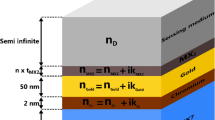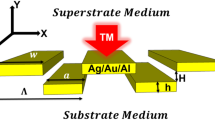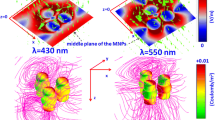Abstract
In this paper, we report on a general method to optimise the optical characteristics of 2D-arrays of plasmonic gold nanoantennas performing as band-pass filter functionalised metasurfaces to be used as high-sensitivity mid-infrared spectroscopic sensors. We demonstrate that it is possible to increase their sensitivity in the detection of chemical and biological substances when the sensors are used in the surface-enhanced infrared absorption (SEIRA) technique. This technique allows revealing the presence of a substance adsorbed on the nanoantennas by measuring its optical absorption under the conditions for which the maximum value of the functionalised metasurface reflectivity occurs at the same wavelength of the substance maximum absorption peak. In particular, numerical simulations based on finite element method of the metasurface detection response demonstrate the possibility to increase the sensor sensitivity of more than four orders of magnitude with respect to that one achievable if the same amount of the substance is deposited on an unstructured planar metal surface. These results can be obtained by acting on the 2D-array periodicity, nanoantenna shape (i.e. rod and cross), size and thickness independently from the wavelength at which the substance absorption occurs. Moreover, in the case of cross-shaped nanoantennas, we report a complete numerical characterisation of the dependence of the metasurface maximum reflectivity and peak wavelength on the variation of the geometrical parameters of both the nanoantennas and the 2D-array.






Similar content being viewed by others
References
Padilla WJ, Aronsson MT, Highstrete C, Lee M, Taylor AJ, Averitt RD (2007) Electrically resonant terahertz metamaterials: theoretical and experimental investigations. Phys Rev B Rapids 75:041102-1–041102-4
Tao H, Strikwerda AC, Liu M, Mondia JP, Ekmekci E, Fan K, Kaplan DL, Padilla WJ, Zhang X, Averitt RD, Omenetto FG (2010) Performance enhancement of terahertz metamaterials on ultrathin substrates for sensing applications. Appl Phys Lett 97:261909-1–261909–3
Limaj O, Nucara A, Lupi S, Ortolani M, Di Gaspare A, Palange E, Carelli P (2011) Scaling the spectral response of metamaterial dipolar filters in the terahertz. Opt Commun 284:1690–1693
Wang N, Tong J, Zhou W, Jiang W, Li J, Dong X, Hu S (2015) Novel quadruple-band microwave metamaterial absorber. IEEE Photon J 7:5500506-1–5500506-6
Wang C, Wu Y, Zheng H, Li C, Li DJ (2015) Generation of high-order resonance modes in visible and near-infrared range from square ring-disk system. Plasmonics 10:1915–1920
Jackson JD (1998) Classical electrodynamics. John Wiley & Sons Inc., New York
Sederberg S, Elezzabi AY (2011) Nanoscale plasmonic contour bowtie antenna operating in the mid-infrared. Opt Express 19:15532–15537
Chau YF, Lin WH, Sung MJ, Jheng CY, Jheng SC, Tsai DP (2013) Numerical investigation of a castle-like contour plasmonic nanoantenna with operating wavelengths ranging in ultraviolet–visible, visible light, and infrared light. Plasmonics 8:755–761
Lee SE, Park Y, Kang T, Lee LP (2012) Dual function of nanoplasmonic optical antennas: nanoplasmonic gene switches and biosensor. Nanoplasmonic Sensors, Springer, New York
Brown LV, Zhao K, King N, Sobhani H, Nordlander P, Halas NJ (2013) Surface-enhanced infrared absorption using individual cross antennas tailored to chemical moieties. J Am Chem Soc 135:3688–3695
Wang S, Farzani ES, Tao N (2007) Detection of heavy metal ion in water by high-resolution surface plasmon resonance spectroscopy combined with anodic stripping voltammetry. Anal Chem 79:4427–4432
Adato R, Yanika AA, Amsden JJ, Kaplan DL, Omenetto FG, Hong MK, Erramilli S, Altug H (2009) Ultra-sensitive vibrational spectroscopy of protein monolayers with plasmonic nanoantenna arrays. PNAS 106:19227–19232
Neubrech F, Pucci A (2008) Resonant plasmonic and vibrational coupling in a tailored nanoantenna for infrared detection. Phys Rev Lett 101:157403-1–157403-4
Adato R, Altug H (2013) In-situ ultra-sensitive infrared absorption spectroscopy of biomolecule interactions in real time with plasmonic nanoantennas. Nat Comm 4:2154-1–2154-10
Neubrech F, Toma A, Di Fabrizio E, Pucci A (2012) Antenna-assisted surface-enhanced infrared absorption based on nanogaps for ultrasensitive sensors. Proc. of International Congress on Advanced Electromagnetic Materials in Microwaves and Optics: 445–447
Chen X, Ciracì C, Smith DR, Oh SH (2015) Nanogap-enhanced infrared spectroscopy with template-stripped wafer-scale arrays of buried plasmonic cavities. Nano Lett 15:107–113
Hopkins B, Miroshnichenko AE, Poddubny AN, Kivshar YS (2015) Fano resonance enhanced nonreciprocal absorption and scattering of light. Photonics 2:745–757
Hoffmann JM, Janssen H, Chigrin DN, Taubner T (2014) Enhanced infrared spectroscopy using small-gap antennas prepared with two-step evaporation nanosphere lithography. Opt Express 22:14425–14432
Lee EK, Song JH, Jeong KY, Seo MK (2013) Design of plasmonic nano-antenna for total internal reflection fluorescence microscopy. Opt Express 21:23036–23047
Brown LV, Yang X, Zhao K, Zheng BY, Nordlander P, Halas NJ (2015) Fan-shaped gold nanoantennas above reflective substrates for surface-enhanced infrared absorption (SEIRA). Nano Lett 15:1272–1280
Moosmann C, Sigurdsson GS, Wissert MD, Dopf K, Lemmer U, Eisler HJ (2014) Investigating the influences of the precise manufactured shape of dipole nanoantennas on their optical properties. Opt Express 21:581–594
Liberman V, Adato R, Jeys TH, Saar BG, Erramilli S, Altug H (2012) Rational design and optimization of plasmonic nanoarray for surface enhanced infrared spectroscopy. Opt Express 20:11953–11966
Dmitruk I, Blonskiy I, Pavlov I, Yeshchenko O, Alexeenko A, Dmytruk A, Korenyuk P, Kadan V (2009) Surface plasmon as a probe of local field enhancement. Plasmonics 4:115–119
Mayer SA (2007) Plasmonics: fundamentals and applications. Springer US
Author information
Authors and Affiliations
Corresponding author
Rights and permissions
About this article
Cite this article
De Marcellis, A., Palange, E., Janneh, M. et al. Design Optimisation of Plasmonic Metasurfaces for Mid-Infrared High-Sensitivity Chemical Sensing. Plasmonics 12, 293–298 (2017). https://doi.org/10.1007/s11468-016-0263-9
Received:
Accepted:
Published:
Issue Date:
DOI: https://doi.org/10.1007/s11468-016-0263-9




